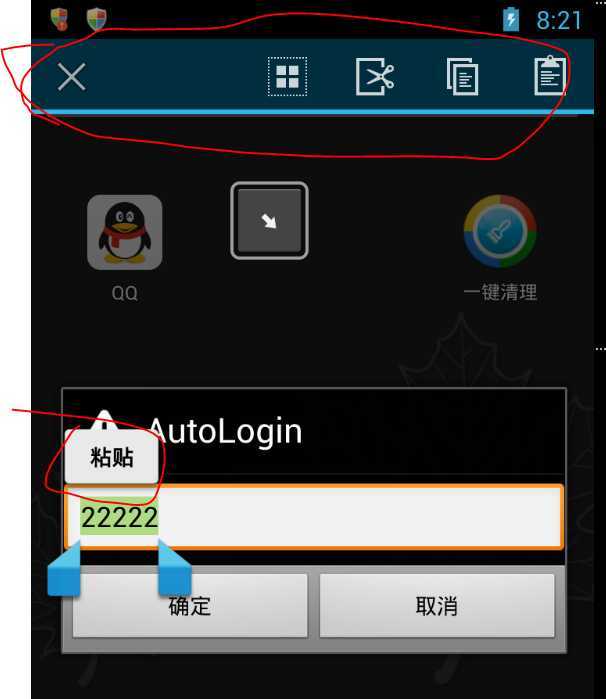标签:
当Dialog有编辑框时如果选择会弹菜单窗口就不要用

package com.android.autologin; import android.app.Activity; import android.app.AlertDialog; import android.content.DialogInterface; import android.content.DialogInterface.OnDismissListener; import android.os.Bundle; import android.widget.EditText; /** * This is the dialog Activity used as an AlertDialog for the user to interact. * Requires android:launchMode="singleInstance" in your AndroidManifest to work * properly. * <p/> * 当Dialog有编辑框时如果选择会弹菜单窗口就不要用 AlertDialog(Application) * 再添加WindowManager.LayoutParams. TYPE_SYSTEM_ALERT, * <pre> * Context applicationContext = mainActivity.getApplicationContext(); * AlertDialog.Builder dlgBuilder = new AlertDialog.Builder(applicationContext); * EditText et = new EditText(mainActivity); * dlgBuilder.setTitle(mainActivity.getTitle()); * dlgBuilder.setPositiveButton(android.R.string.ok, null); * dlgBuilder.setNegativeButton(android.R.string.cancel, null); * dlgBuilder.setIcon(android.R.drawable.ic_dialog_alert); * dlgBuilder.setView(et); * AlertDialog dialog = dlgBuilder.create(); * dialog.getWindow().setType(WindowManager.LayoutParams.TYPE_SYSTEM_ALERT); * dialog.show(); * </pre> * 防止报错 * attrs.token = null, * BadTokenException("Unable to add window -- token " + attrs.token + " is not for an application") * * @usage * * <i>.java</i> * * <code><pre> * Intent dialogIntent = new Intent(mContext, AlertActivity.class); * dialogIntent.setFlags(Intent.FLAG_ACTIVITY_NEW_TASK); * mContext.startActivity(dialogIntent); * </pre></code> * * <i>AndroidManifest.xml</i> * * <pre> * < activity * android:name=".AlertActivity" * android:excludeFromRecents="true" * android:finishOnTaskLaunch="true" * android:launchMode="singleInstance" * android:theme="@android:style/Theme.Dialog" > * < /activity> * </pre> * * @author Sansan **/ public class AlertActivity extends Activity implements DialogInterface.OnClickListener, OnDismissListener { @Override protected void onCreate(Bundle savedInstanceState) { super.onCreate(savedInstanceState); // setContentView(R.layout.alertactivity); // Get root view from current activity // @see http://stackoverflow.com/questions/4486034/get-root-view-from-current-activity // //rootview //// check layouts in hierarchyviewer. // findViewById(android.R.id.content) is giving me the root view // findViewById(android.R.id.content).getRootView() //getWindow().getDecorView().findViewById(android.R.id.content) // //------------------------------------------------------------------------------------------- // //This is what I use to get the root view as found in the XML file assigned with setContentView // //This answer gave the view without the status bar - which is what I wanted. I was looking for // //the pixel width + height of the visible part of the activity. This one works, thanks! // //This excludes ActionBar! //final ViewGroup viewGroup = (ViewGroup) ((ViewGroup) this.findViewById(android.R.id.content)).getChildAt(0); // //------------------------------------------------------------------------------------------- // //------------------------------------------------------------------------------------------- // //I tested this in android 4.0.3, only: // // getWindow().getDecorView().getRootView(); // // //give the same view what we get from // // anyview.getRootView(); == com.android.internal.policy.impl.PhoneWindow$DecorView@######### // // //and // // getWindow().getDecorView().findViewById(android.R.id.content) // //giving child of its == android.widget.FrameLayout@####### // //Please confirm. // //------------------------------------------------------------------------------------------- //getWindow().getDecorView().setVisibility(View.GONE); //requestWindowFeature(Window.FEATURE_NO_TITLE);//去掉标题栏 // //Error, if select any text to pop up a system menu view, such as // paste in // // the Dialog. // //@see android/view/ViewRootImpl.java // //case WindowManagerGlobal.ADD_NOT_APP_TOKEN: throw new // //WindowManager.BadTokenException("Unable to add window -- token " + // //attrs.token + " is not for an application"); // Context applicationContext = this.getApplicationContext(); // AlertDialog.Builder dlgBuilder = new // AlertDialog.Builder(applicationContext); AlertDialog.Builder dlgBuilder = new AlertDialog.Builder(this); EditText et = new EditText(this); dlgBuilder.setTitle(this.getTitle()); dlgBuilder.setPositiveButton(android.R.string.ok, AlertActivity.this); dlgBuilder.setNegativeButton(android.R.string.cancel, AlertActivity.this); dlgBuilder.setIcon(android.R.drawable.ic_dialog_alert); dlgBuilder.setView(et); AlertDialog dialog = dlgBuilder.create(); // dialog.getWindow().setType(WindowManager.LayoutParams.TYPE_SYSTEM_ALERT); dialog.setCanceledOnTouchOutside(false); dialog.setOnDismissListener(this); dialog.show(); } /** * meanwhile, finish the AlertActivity. */ @Override public void onDismiss(DialogInterface dialog) { finish(); } @Override public void onClick(DialogInterface dialog, int which) { } }
Pop up a top alert Dialog like TYPE_SYSTEM_ALERT
标签:
原文地址:http://www.cnblogs.com/Fang3s/p/4189603.html